

August 31, 2016
I usually hate putting in earplugs, but the roar of the P-3 plane makes me get over my aversion quickly. We’re a little less than an hour away from take-off, and people are moving from the hangers that are serving as our base of operations at Walvis Bay Airport to the aircraft. Before joining them, one other graduate student and I have to complete a short safety briefing — for both of us, this will be our first journey on the P-3.
I’m currently finishing up my first year as a graduate student in the Department of Atmospheric Sciences at the University of Washington, Seattle. My advisor, Professor Rob Wood, is the deputy principal investigator of ORACLES, and beyond helping him out in the field, my role will be using the data we collect to better understand the interaction between smoke and cloud particles over the southeast Atlantic.

Me (Michael Diamond) and Sam LeBlanc (a scientist working at the NASA Ames sun photometer instrument group) taking dueling photos from aboard the P3. Photo credit: Sam LeBlanc and Michael Diamond. You can guess in which order 🙂
After safety training is complete, we’re able to board the plane. There are no beverage carts, movies, or reclining seats on this flight, but we do have some other perks. We have a microwave and — in my opinion more importantly — a coffeemaker in the back of the plane. There are screens, but instead of showing Zootopia or season 3 of Friends, these show the data our instruments are collecting and have various controls depending on the instrument. Racks of instrument machinery take the place of some rows of seats. We even have a version of in-flight WiFi, although this version has a somewhat more limited offering: forward and nadir (directly below the plane) cameras, a few live-streams of the data being collected, some satellite images, and the flight map.
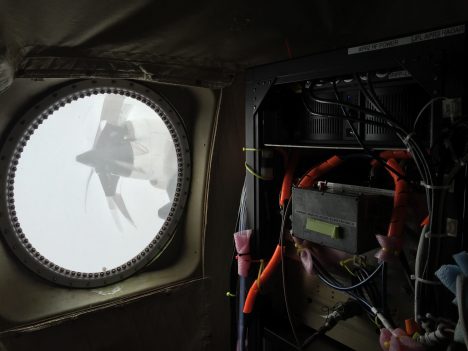
One of the instruments aboard the P-3 with the P-3’s propeller visible out the window. Photo credit: Michael Diamond
This will technically be our second official science flight of the ORACLES campaign, although some people have been calling it “1b” because the first flight had to turn around early due to a mechanical issue. Conditions are fairly good for flying today, with the caveat that there are some mid-level “altocumulus” clouds in our flight path. The “cartoon” version of the system we’re studying would be uniform, low-level stratocumulus clouds (incredibly long expanses of relatively thin, fluffy clouds) overlain by a layer of smoke produced from fires in central Africa and lofted over the Atlantic Ocean by the prevailing wind patterns. This stratocumulus deck reflects a lot of sunlight during the day and thus plays an important role in cooling Earth’s climate, which is why it’s so important to understand how the clouds are affected by largely man-made fires. The mid-level clouds add another wrinkle to this already complex system.
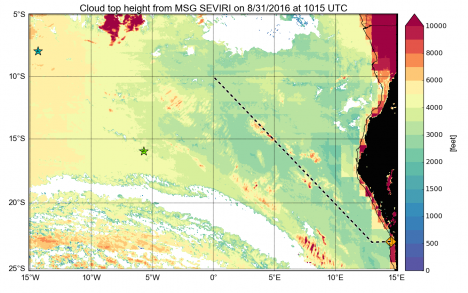
Map of the southeast Atlantic and coastal west Africa with our flight track marked in black/white dashes. The mid-level clouds can be seen in the satellite-estimated cloud top heights as the yellow-to-red colors around 5° East and 15° degrees South. Walvis Bay, our starting point, is marked as the orange diamond.
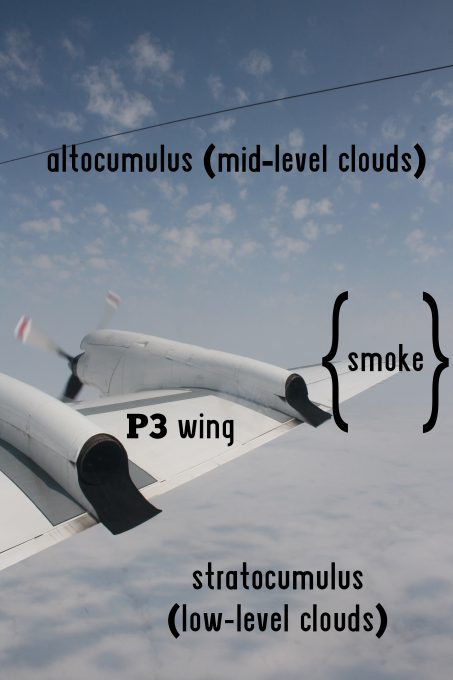
Schematic from outside the P-3 window of mid-level clouds, the smoke layer, and the low-level stratocumulus clouds. Credit: Michael Diamond
In addition to flying over the stratocumulus clouds, we also fly through and below them to take advantage of the unique capabilities of each of the P-3 instruments and to study the marine boundary layer, which is an atmospheric science term referring to the shallow, extremely well-mixed layer of air just over the ocean and topped by the stratocumulus clouds. As anyone who’s been on a commercial airliner can attest, cloud layers are turbulent, and the marine boundary layer is also very turbulent, so this can lead to a rather bumpy ride.
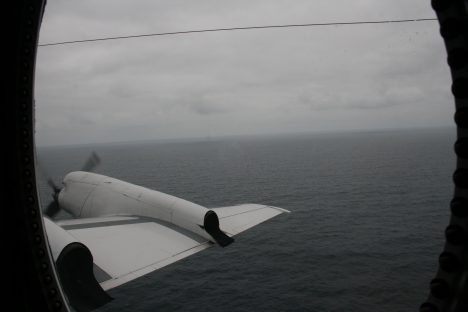
View of the marine boundary layer with stratocumulus clouds above and the Atlantic Ocean below from outside the P-3 window. Photo credit: Michael Diamond
Despite getting a bit high-altitude-over-sea sick, I enjoyed my first flight on the P-3, and the initial indication is that we collected some high-quality data. If September’s flights are as successful as flight “1b,” we’ll be coming back with a ton of great climate information. And then comes the hardest part: analyzing all that data!
As the soaking rains of the summer wet-season subside in early July, the vast savannas of the southern half of the African continent dry out and turn from green to brown to a crispy yellow. Local farmers take advantage of the dried-out vegetation and burn the aged remains of crops before plowing and harrowing in an effort to return vital nutrients to the soil. The result of all this dry-season burning is a large, thick, persistent plume of smoke that stretches from the eastern coasts of Mozambique out over the southern Atlantic Ocean, sometimes reaching past Ascension Island on its way to Brazil. In many years, this plume persists, almost unbroken, from August through October.
A team of 100 plus scientists from NASA and universities are here on the far west coast of Namibia in the small desert resort town of Swakopmund to study the impact that this expansive plume of smoke has on low cloud dynamics over the Atlantic Ocean. Our mission is called the Observations of Aerosols Above Clouds and their Interactions, or ORACLES.
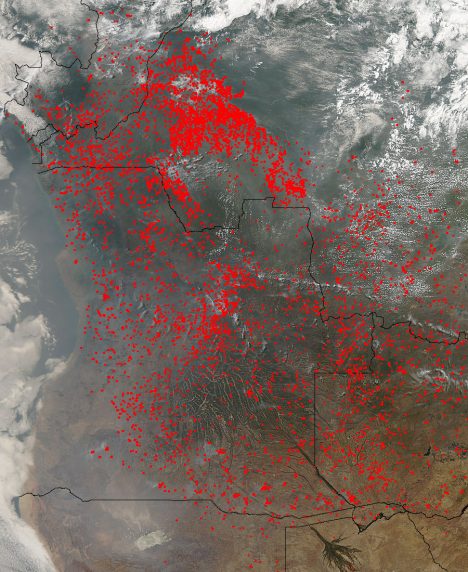
A MODIS satellite image from 21-08-2013 showing abundant fire (red dots) and an expansive plume of smoke originating in Angola and stretching out over the open Atlantic where it interacts with low clouds. Credit: NASA
We’re using two research aircraft – the P-3 and the ER-2 (shown below) – equipped with over a dozen instruments and team members from a more than a dozen countries, to study these interactions from above, below and even within the clouds and smoke. I personally work with an instrument that is on-board the ER-2, but, just last week (August 31), the P-3 aircraft had its first successful research flight over the open Atlantic and flew through some impressive regions of smoke.

Scientists and engineers working on the P-3 aircraft which is currently stationed at Walvis Bay International Airport, Namibia. Photo by Mike Tosca.
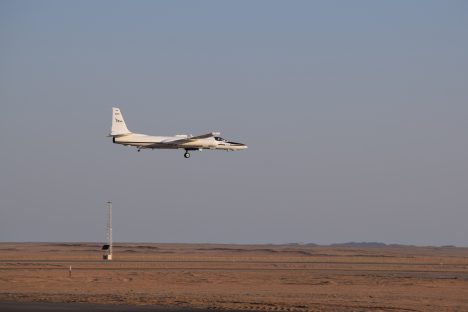
A spectacular image of the ER-2 aircraft landing at Walvis Bay International Airport on August 26, 2016. Photo by Brian Rheingans.
Before arriving in Swakopmund, I, personally, had the great privilege of seeing this impressive plume of smoke overland and in “the wild”. I spent three days touring the incredible Etosha National Park in far northern Namibia where I was able to see a menagerie of megafauna (elephants, lions, giraffes, oh my) juxtaposed against an almost surreal background of grey, smoky skies. It goes without saying that the thick smoke – which originated from biomass burning in many cases hundreds of miles away in Zambia and beyond – helped produce some of the most spectacular sunsets I’ve ever seen.
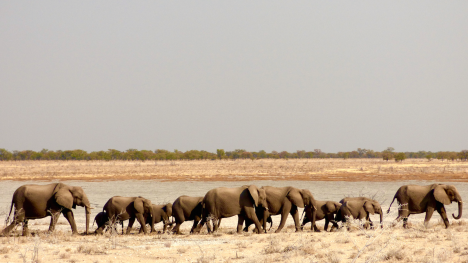
A family of elephants in Etosha National Park is an impressive foreground subject to a gray sky filled with biomass burning smoke originating in central Africa. Photo by Mike Tosca.
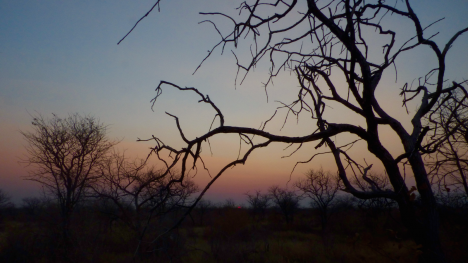
A brilliant sunset viewed through a layer of biomass burning smoke from Etosha National Park on August 18, 2016. Photo by Mike Tosca.
This research campaign is just ramping up, but the smoky skies and the cloudy Atlantic are already proving to be the perfect real-life research laboratory for questions about the complex and not-well-understood interactions between smoke particles and low clouds. I think I speak for the scientific community when I say that I’m looking forward to the incredible and first-of-their-kind data that are sure to come out of this campaign over the next month or so.
Mike Tosca is an research scientist at NASA’s Jet Propulsion Laboratory in Pasadena, California.
By Eric Lindstrom
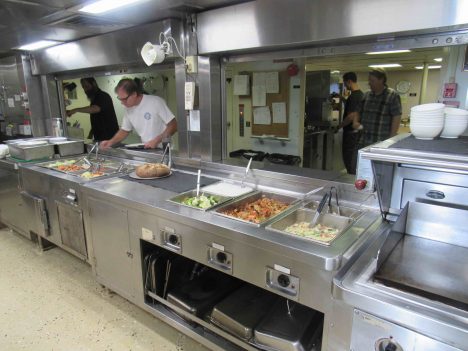
Food service on the R/V Revelle.
Food aboard the R/V Revelle is a cornerstone of happiness and good morale. Jay Erickson and Richard Buck are the cooks during this voyage and have many years of experience working together on R/V Revelle. I followed their daily routine all day on Friday, September 2, so that I can give you some beyond-consumer incite about food on the R/V Revelle. I will stipulate that their work is very good indeed and that we have been getting well fed. Since scales don’t work at sea, no weight gain can be observed. So says the fat blogger.

Jay Erickson, Chief Cook on the R/V Revelle.
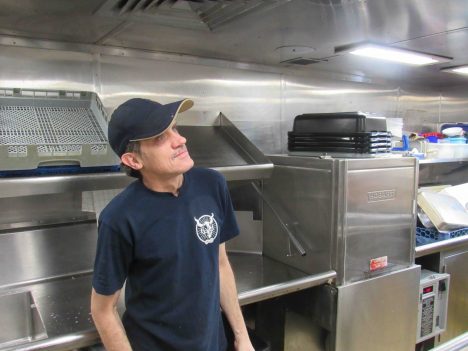
Richard Buck, Cook, R/V Revelle.
I think it is best to describe this important aspect of life on R/V Revelle in two ways. First is the routine that makes food service run like clockwork every day. Second are the secrets or magic of shipboard food service that those on land might find curious or amazing. I can touch on only a few highlights.
I’ll start with the clockwork routine. Richard and Jay alternate work assignments. Each day one them does the hot food preparation and other has salad/cold food preparation, cleaning/dishwashing, and supply runs to the stores (three decks down). The next day they switch. The key menu options for hot food are generally decided on the prior evening. Only one day has a predictable menu – Sunday is steak day! Jay and Richard’s workdays are over 12 hours long with two short breaks. That is a heavy, relentless duty.
Breakfast preparation starts at 6:00 am. Breakfast food options are those of a typical American diner (e.g., eggs several ways, several meats, potato, pancakes, oatmeal, cereal, fresh fruit), without the short orders, and do not vary substantially from day to day. Most people do not vary in their breakfast food choices so I’d characterize it as the constant, dependable meal (least challenging for the cooks).
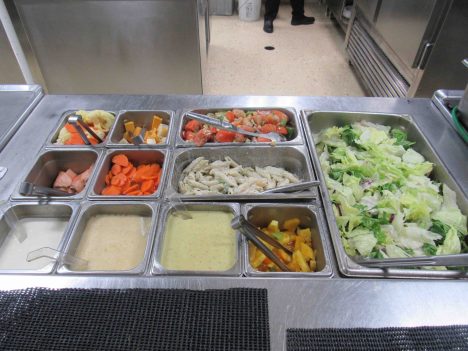
Salad bar at every meal.
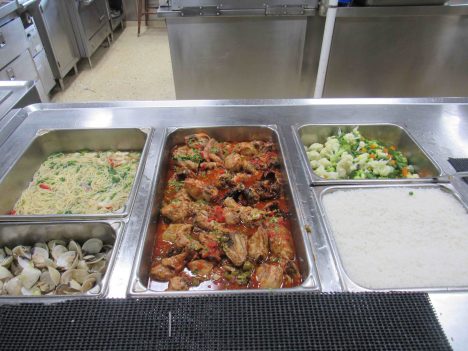
Hot meal of Balboa chicken and shrimp noodle soup.
After a short break from about 8:30 to 9:00 am, lunch preparation begins with galley and dining room cleaning. Typical lunch and dinner menus include a featured main course, a couple of side dishes, a vegetarian option, and a soup. After lunch cleanup there is another break in the action from around 1:30 to 2:30 pm. Some preparation for dinner will have been started during the lunch service.

Birthday cake for Andrew and Peter.
Dinner preparation includes renewal and refreshment of the salad bar, bread baking, and work on the main meal from soup to nuts, as they say. Every day there are some extras or special events as well. On my day in the kitchen there were two birthdays, so a decorated birthday cake was prepared over the course of the day. Likewise, fresh bread, cookies, or a special dessert might be created for the dinner service.
As I learned over the course of the day, the vast share of labor goes into food preparation and cleanliness. The R/V Revelle professional facilities allow for the rapid and efficient cooking of food for 50-60 people. However, the washing and chopping of large quantities of fruit and vegetables, and meat handling are labor intensive. So too are the good habits of kitchen hygiene that assure that everything is done right and sparkling clean at all times. As you might expect, the work is hard enough without everything being shipshape and well organized. Fastidiousness was a hallmark of Jay and Richard’s work.
There are many challenges to creation of good meals at sea. Obviously motion of the ship can be a big issue. A ship’s cook is a cook who has mastered the art of corralling sloshing food! Richard told me of attempts to bake a level cake in the seas of the Southern Ocean. Rather than having it baked into the leaning cake of Pisa, he tried to balance the sea motion by turning the cake in the oven every few minutes to counter the sloshing of the batter. In that case, the ocean won…but I think the birthday recipient appreciated the effort nonetheless.
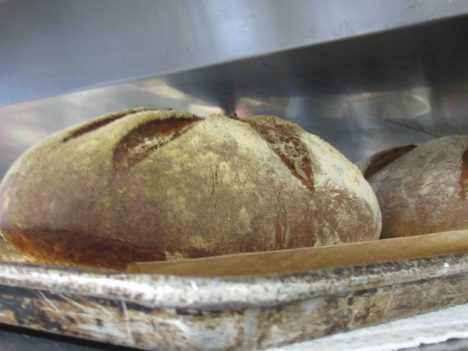
Fresh bread just out of the oven.
Jay shared an interesting secret of leftovers. Oatmeal is available for breakfast every day. Leftover oatmeal is mixed with water and yeast after breakfast and the slurry left to ferment. It is transformed by this effort of the microbes and a resourceful cook into the delicious bread at dinner!

Let us admire a three-week-old lettuce, looking like it was fresh.
A great deal of science and experience goes into the food storage on a ship. Three weeks at sea and we still have lettuce and perfect avocados. That never happens for me at home! While each fruit and vegetable seems to have its own story with regard to ripeness at purchase, storage, and revitalization, the keys to longevity seem to be in the cold room temperature and humidity plus the skills of Jay and Richard to give foods a second chance. Lettuce, for example, might look finished due to a dehydrating stay in the cold storage, but skilled knife work, a cold bath, and a little secret chemistry can return lettuce to salad fitness!
We are all in debt to the skill and labor of Richard and Jay. We will feel the full extent of the deliciousness they loaned to us when we climb on the scale back home!
By Eric Lindstrom

The R/V Revelle and the Lighter-Than-Air InfraRed System (on the left corner), as seen from the Surface Salinity Profiler. Credit: Dan Clark.
Kyla Drushka from University of Washington Applied Physics Laboratory (APL) received a National Science Foundation grant to participate in SPURS-2. It is one cornerstone of our work and is entitled “Rain-Formed Fresh Lenses in SPURS-2.” The idea of rainfall resulting in freshwater puddles or lenses at the sea surface is (perhaps) easy to imagine but is very tricky to observe and study in the real world. SPURS-2 will provide a wealth of new data on this subject with which to test the fidelity of our scientific imagination.
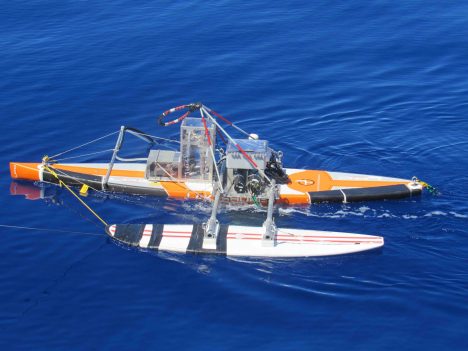
A beauty shot of the Surface Salinity Profiler.
Kyla and the APL crew have a variety of instruments aboard R/V Revelle but the Surface Salinity Profiler (SSP) is central to SPURS-2 science objectives. When you want to know the fate of rainwater after it hits the sea surface, measuring salinity (or equivalently the amount of freshwater) in the upper meter of the ocean is crucial. The profile of salinity in that top meter of the ocean is elusive for a number of reasons – technical and logistical. Technically, salinity sensors require some time and bubble-free water flow to make the measurement. However, normally the sea surface is rapidly moving up and down (because of waves!) so a sensor is not always in the water and away from bubbles until it is several meters below the surface. Finding a way to tow salinity (and other) sensors at fixed, shallow depths following the motions of the sea is another approach. APL scientists and engineers including Andy Jessup, Bill Asher, and Dan Clark designed the SSP to apply this approach.
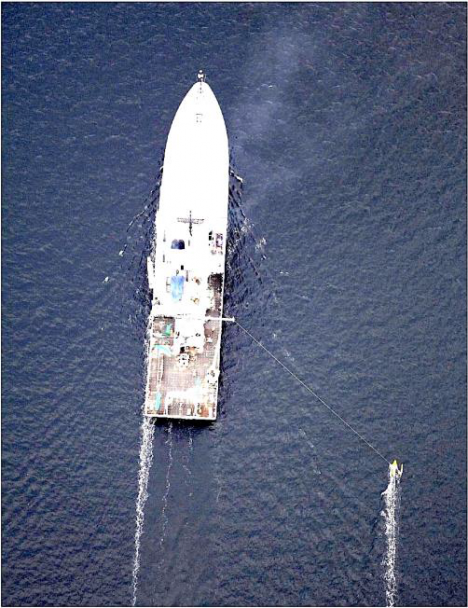
How the Surface Salinity Profiler runs outboard the ship — photo taken from the Lighter-Than-Air InfraRed System balloon camera.
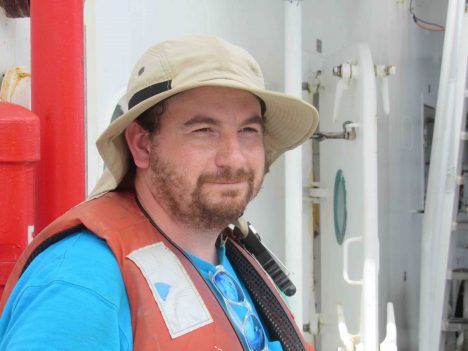
Dan Clark, APL engineer extraordinaire.
The SSP platform is a converted paddleboard with a keel and surfboard outrigger. It is tethered to the ship so it skims the sea surface outside the wake or influence of the ship. Below the paddleboard, on the leading edge of the keel, are salinity (and temperature) sensors at depths of 10 centimeters (4 inches), 30 centimeters (1 foot), 50 centimeters (1.64 feet), and 100 centimeters (3.28 feet), microstructure sensors (to estimate turbulence), and cameras. The Salinity Snake (see my last blog entry) supplements the SSP by providing temperature and salinity in the upper few centimeters of the ocean. The SSP can be towed for many hours before the instrument batteries need refreshing.
Deployment of SSP is most informative when there is a rain event, leading to stratification of the near-surface ocean with less dense fresher water on top of denser saltier water. If there is a rain event ahead of the ship, the SSP goes in the water. Then it can measure how the ocean changes over the periods from before rain, during rain, and recovering from rain. Salinity from several depths and simultaneous turbulence estimates are then used to determine how rainwater mixes into the ocean.
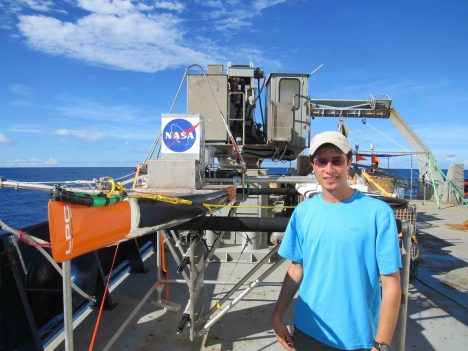
Suneil Iyer with Surface Salinity Profiler on deck (sensor to bottom left on keel)
Suneil Iyer is a new graduate student at University of Washington who will work with Kyla on interpretation of the microstructure measurements from the SSP data. He just arrived in Seattle from his hometown of Kansas City, Kansas, one week before the R/V Revelle departure from Honolulu. He just had time to find an apartment before jumping on a plane for SPURS-2. Graduate school in oceanography can be a blast of new experiences! This is not his first exposure to physical oceanography: Suneil worked on tides in estuaries during his undergraduate work at University of South Carolina.

Kyla Drushka working on the Surface Salinity Profiler.
Kyla Drushka joined UW in 2014 after PhD work at Scripps Institution of Oceanography. She is now an active member of NASA’s Ocean Salinity Science Team and the mission science team for the Surface Water Ocean Topography satellite that is planned for launch in April 2021.
This blog entry goes to press near an auspicious moment on R/V Revelle SPURS-2 voyage. Saturday at 2 am (local time) is the halfway point of our expedition! In our oceanography lexicon we would call this the “hump day” for our voyage. For all you land-loving 5-day-a-weekers hump day might mean Wednesday. For the 24/7 work at sea, we really have only a “hump moment” to mark the halfway point of a continuous work schedule. Like any good NASA activity, people aboard have countdowns running to both our hump moment and our arrival back in Honolulu (8 am on Sept. 23). Amusement is in short supply!